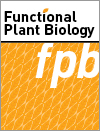
Functional Plant Biology
Volume 48 Number 10 2021
FP20349Systematic review of defense responses against Phytophthora and strategies to manage Phytophthora diseases in citrus
 , Kaliane N. S. Pinto, Bianca E. Maserti, Hermes P. Santos-Filho and Abelmon da S. Gesteira
, Kaliane N. S. Pinto, Bianca E. Maserti, Hermes P. Santos-Filho and Abelmon da S. Gesteira 
This systematic review provides an updated overview of the main defence responses in citrus against different species of Phytophthora and of diseases management strategies in citrus, spreading from the classical management approach to the new biotechnology techniques for breeding resistant citrus rootstocks.
FP20405Screening and functional identification of antioxidant microRNA-size sRNAs from Spirulina platensis using high-throughput sequencing

High-throughput sequencing of msRNAs were implemented from Spirulina platensis in H2O2 stress. Eight changed msRNAs were identified and confirmed experimentally under H2O2 stress. Expression changes of 13 genes displayed reversely patterns compared with their msRNAs. The target genes functions were mainly related to glycolysis and chlorophyll metabolism. These findings msRNA play important regulatory roles in oxidative stress responses.
Transcripts relating to the chlorophyll content of Oryza sativa L. (rice) seedlings grown at low (18°C) temperatures were investigated using RNA-sequencing. The statistical approaches revealed that the expression levels of stress-responsive genes were significantly negatively correlated with chlorophyll content at low temperatures. These suggest that the statistical method could help the clarification of the metabolic mechanisms underlying the response of rice to low temperatures.
FP21088 Abstract | FP21088 Full Text | FP21088PDF (657 KB) | FP21088Supplementary Material (385 KB) Open Access Article
FP21134Effect of thiamethoxam on photosynthetic pigments and primary photosynthetic reactions in two maize genotypes (Zea mays)

Maize is an important crop that is often attacked by various insect pests, We studied the effects of the neonicotinoid insecticide thiamethoxam, which can be transported through the xylem vasculature within the plant, and can persist for weeks after application. Photosynthesis effectiveness is crucial for yield; therefore, it is important to understand the effect of neonicotinoids on photosynthetic activity and detect these changes timely through non-invasive technique.
FP21156PLDα1 and GPA1 are involved in the stomatal closure induced by Oridonin in Arabidopsis thaliana

Allelopathy is an important mechanism in the process of plant invasion. The allelopathy of Oridonin in the stomatal development of plants is yet to be explored. Using Arabidopsis thaliana L., this work investigated the mechanisms that Oridonin induce stomatal closure by affecting GPA1 and promoting PLDα1 to produce PA, and further accumulating H2O2 to upregulate gene OST1. This study aimed to reveal the response of plants to diterpene allelochemicals to lay a foundation for the future study of plant response allelopathy.
This study explores the patterns of leaf phenotypic variation and integration in a sclerophyllous plant. Stomatal limitation varies with leaf morphology under drought stress, whereas it varies with leaf P investment under soil P deficiency. Leaf water-use efficiency was robustly correlated with leaf nutrients in water shortage, but not in P deficiency. The structure of trait covariation varies remarkably under different stressors, indicating that the pathways of strategic compromise are locally specialised.
FP21013TaPCNA plays a role in programmed cell death after UV-B exposure in wheat (Triticum aestivum)
Plants are immobile and must adapt to changes in their surroundings, such as ultraviolet (UV)-B from sunlight. The mechanism of programmed cell death (PCD) in plants under UV-B radiation is unclear. Our results showed that UV-B radiation induced extensive PCD after the TaPCNA was silenced by Barley Stripe Mosaic Virus–virus-induced gene silencing. Thus, this study provides a basis for future targeted modification of plants.
FP21013 Abstract | FP21013 Full Text | FP21013PDF (2.3 MB) Open Access Article
Pearl millet is an important C4 cereal plant that possess enormous capacity to survive under extreme climatic conditions. GRAS is an important transcription factor gene family of plant that play a critical role in developmental processes, stress responses and phytohormonal signalling. The aim of this study was to identify GRAS members and to understand evolutionary progression of GRAS family in pearl millet. The findings provide clear understanding about role of GRAS genes and lay a good foundation for the functional characterisation of GRAS genes.
We investigated the capacities and responses of the euhalophyte SaLi-Cornia perennans Willd. and glycohalophyte Artemisia santonica L. to accumulate natural (NaCl) and anthropogenic salts (Cu(NO3)2 and Cd(NO3)2). The eugalophyte S. perennans is characterised by accumulation of metal ions (as in its natural environment), whereas the glycohalophyte A. santonica is salt-resistant. Our findings suggest that S. perennans can be used for heavy metals extraction from soil in phytoremediation, while A. santonica will be more effective for greening of polluted territories.
Future space missions will require fully fledged plant development in a closed ecosystem in weightlessness. Such conditions of microgravity are modelled on Earth using two-axial clinorotation, under which Arabidopsis thaliana (L.) Heynh. seedlings demonstrate altered phenotype and cytoskeleton organisation, and consequently accumulate less biomass. However, our data suggest that the ‘scattered’ organisation of cytoskeleton may be rapidly converted to a normal structure under the action of gravity vector.
FP21084Gimme shelter: three-dimensional architecture of the endoplasmic reticulum, the replication site of grapevine Pinot gris virus
 , Alberto Loschi, Sara Buoso, Gregor Kapun
, Alberto Loschi, Sara Buoso, Gregor Kapun  , Paolo Ermacora and Rita Musetti
, Paolo Ermacora and Rita Musetti 
Grapevine leaf mottling and deformation (GLMD) is a novel grapevine disease that has been associated with grapevine Pinot gris virus (GPGV). Despite the increase in the number of reports describing GLMD in vineyards worldwide, the literature still lacks information on virus–grapevine interactions at the cytological and molecular level. The results reported in this work contribute to understanding the biology of GPGV in its natural host and to improving knowledge of the novel GLMD disease, whose aetiology is still poorly understood.




